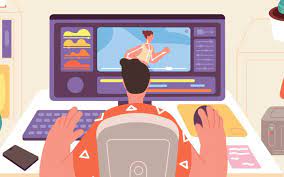The Art of Motion Design: Bringing Creativity to Life
Motion design is a dynamic and versatile form of visual communication that combines graphic design, animation, and filmmaking to create engaging and captivating visuals. Motion designers are the masterminds behind animated logos, title sequences, explainer videos, and dynamic graphics that bring life and movement to static images.
What sets motion design apart is its ability to convey complex ideas and narratives through the seamless integration of text, graphics, and animation. By manipulating timing, pacing, and transitions, motion designers can evoke emotions, convey messages, and tell stories in a visually compelling way.
From sleek corporate presentations to eye-catching advertisements to immersive user interfaces, motion design plays a crucial role in shaping our digital experiences. Whether it’s adding subtle animations to a website or creating a full-blown animated short film, motion designers use their creative skills to enhance visual communication across various media platforms.
One of the key skills of a motion designer is the ability to balance technical expertise with artistic vision. They must have a solid understanding of animation principles, typography, color theory, and composition while also staying updated on the latest software tools and technology trends in the industry.
Collaboration is also essential for motion designers as they often work closely with graphic designers, illustrators, filmmakers, and other creative professionals to bring their ideas to life. By combining their skills with those of others in a multidisciplinary team, motion designers can create truly innovative and impactful visual experiences.
In today’s fast-paced digital world where attention spans are short and competition is fierce, motion design has become an indispensable tool for brands and businesses looking to stand out in the crowded marketplace. With its ability to engage audiences on an emotional level and communicate complex concepts effectively, motion design continues to push the boundaries of visual storytelling and creativity.
6 Essential Tips for Aspiring Motion Designers: Building Skills, Creativity, and Career Opportunities
- Develop a strong foundation in design principles and animation techniques.
- Stay updated on the latest trends and software in motion design.
- Practice regularly to improve your skills and creativity.
- Collaborate with other creatives to gain new perspectives and ideas.
- Create a diverse portfolio showcasing your range of styles and capabilities.
- Network with professionals in the industry to explore job opportunities and stay connected.
Develop a strong foundation in design principles and animation techniques.
To excel as a motion designer, it is crucial to develop a solid foundation in design principles and animation techniques. Understanding concepts such as composition, color theory, typography, and layout will provide the framework for creating visually appealing and effective motion graphics. Additionally, mastering animation techniques like timing, easing, keyframing, and sequencing is essential for bringing movement and life to static elements. By honing these fundamental skills, motion designers can elevate their work to new levels of creativity and impact, ensuring that their animations resonate with audiences and effectively convey messages.
Stay updated on the latest trends and software in motion design.
To excel as a motion designer, it is crucial to stay updated on the latest trends and software in the field. By keeping abreast of emerging technologies, design styles, and industry best practices, motion designers can ensure that their work remains fresh, relevant, and competitive. Embracing new tools and techniques not only enhances creativity but also allows designers to push the boundaries of their craft and deliver cutting-edge visual experiences that captivate audiences. Continuous learning and adaptation to evolving trends are key factors in staying ahead in the dynamic world of motion design.
Practice regularly to improve your skills and creativity.
To excel as a motion designer, it is essential to practice regularly to enhance your skills and nurture your creativity. By dedicating time each day to experimenting with new techniques, exploring different styles, and pushing your creative boundaries, you can continuously improve and grow as a motion designer. Consistent practice not only hones your technical abilities but also fosters innovation and originality in your work, allowing you to develop a unique artistic voice and stay ahead in the ever-evolving field of motion design.
Collaborate with other creatives to gain new perspectives and ideas.
Collaboration with other creatives is a valuable tip for motion designers seeking to expand their horizons and enhance their creative process. By working with individuals from different backgrounds and disciplines, motion designers can gain fresh perspectives, innovative ideas, and unique insights that can elevate their work to new heights. Through collaboration, motion designers can tap into a diverse pool of talent, share knowledge, and combine skills to create truly original and impactful visual experiences that resonate with audiences on a deeper level.
Create a diverse portfolio showcasing your range of styles and capabilities.
When aiming to establish yourself as a successful motion designer, it is crucial to curate a diverse portfolio that highlights your versatility and creative abilities across different styles and techniques. By showcasing a range of projects that demonstrate your adaptability and skill set, you not only attract a wider audience but also demonstrate your capacity to tackle various design challenges with finesse. A diverse portfolio not only showcases your technical proficiency but also reflects your artistic vision and potential for innovation, making you a more appealing and competitive candidate in the dynamic field of motion design.
Network with professionals in the industry to explore job opportunities and stay connected.
Networking with professionals in the motion design industry is a valuable tip for aspiring motion designers. By connecting with experienced professionals, attending industry events, and engaging in online communities, aspiring motion designers can gain insights into the latest trends, techniques, and job opportunities. Networking not only helps in exploring potential job openings but also allows individuals to build relationships, seek mentorship, and stay connected with the dynamic and ever-evolving world of motion design. Building a strong professional network can open doors to new opportunities, collaborations, and growth in one’s career as a motion designer.

